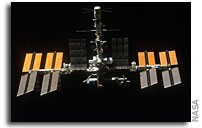NASA Space Station Lead Increment Scientist’s Highlights For the Week of July 11, 2012

(Highlights: Week of June 11, 2012) — The Alpha Magnetic Spectrometer – 02 (AMS-02) has collected its 18 billionth cosmic ray event. The AMS-02 uses the unique environment of space to advance knowledge of the universe and lead to the understanding of the universe’s origin by searching for antimatter, dark matter and measuring cosmic rays.
The last two test point days of the first priority testing of surrogate fuels for the Flame Extinguishment Experiment -2 (FLEX-2) were conducted. FLEX-2 encompasses five distinct investigation classes using pure and bi-component mixed fuels. Surrogate fuels are mixtures of pure fuels that simulate the behavior of real fuels, such as gasoline and jet fuels. Surrogate fuels are chosen for investigation because they allow insight into the burning characteristics of real fuels, which are very difficult to study because they are multi-component. The results from these test points will lead to greater fuel efficiency of liquid-fuel engines and will minimize pollutant emissions. On Earth, FLEX-2 will help in the understanding of combustion generated pollution, and address fire hazards associated with using liquid combustibles.
Operations continued for the Burning And Suppression of Solids (BASS) investigation. BASS examines the burning and extinction characteristics of a wide variety of fuel samples in microgravity. A crew member conducted tests at various air flow speeds and sample widths. The BASS investigation will guide strategies for extinguishing accidental fires in microgravity. BASS results contribute to the combustion computational models used in the design of fire detection and suppression systems in microgravity and on Earth.
A session of the Capillary Flow Experiments – 2 (CFE-2) with the vane gap hardware was completed. CFE-2 is a suite of fluid physics investigations that study how fluids move up surfaces in microgravity. The results aim to improve current computer models that are used by designers of low gravity fluid systems and may improve fluid transfer systems for water on future spacecraft. On Earth, CFE-2 results are also being considered for improving fluid flow in miniaturized biological devices used for health screening and analysis.
The Crew Earth Observation (CEO) team has received 86,852 images for review and cataloging. For this investigation, station crew members photograph natural and human-made changes on Earth. These images provide researchers with key data to better understand the planet.
Human research investigations continued for various crew members including, Pro K, Space Headaches, ALTEA Shield, Hair, Reaction Self Test, Treadmill Kinematics, Integrated Cardiovascular, and Journals.
John Love, Lead Increment Scientist Expedition 30/31








